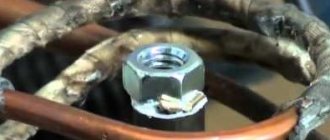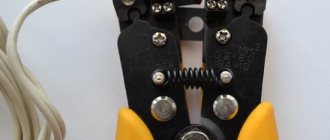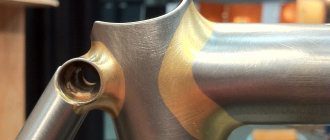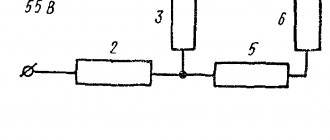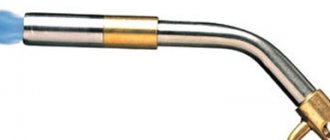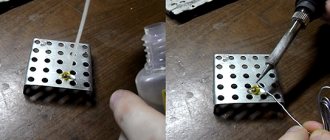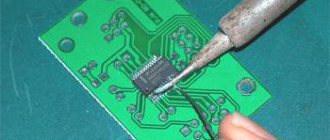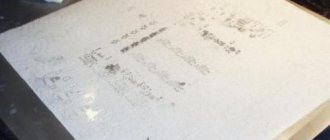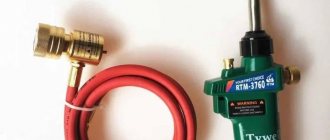Soldering work requires the mandatory use of high-quality flux, which ensures reliable soldering of the material and solder, as well as high electrical conductivity and long service life. Soldering acid is often used as a flux. There are several types of such chemical compounds. The composition of soldering acid directly affects its area of application.
Purpose
To prepare parts for applying solder, it is necessary to clean them of particles of foreign materials - dust, sand, water. In addition, it is necessary to remove the oxide film from the surface, which is present on almost all metals.
And if the first condition is easy to cope with mechanically, using a file, needle file, or sandpaper, then the second condition is difficult to fulfill without the use of chemical compounds - an oxide film very quickly appears on the surface of the metal.
Substances that remove film and prevent the formation of a new one are called fluxes, and the most effective of them is soldering acid. It is an active flux, that is, during soldering it chemically affects the composition of the metal surface.
Professionals never question why soldering acid is needed; they know very well that very often it is impossible to complete the assigned tasks without it.
Soldering acid is used for the following metals:
- copper and its alloys;
- nickel;
- iron;
- structural steel;
- alloys of non-ferrous metals.
If copper or brass parts are successfully soldered with borax, then it is often possible to solder aluminum or steel workpieces to each other only using soldering acid. Upon completion of work, the active flux must be washed off with water containing a small amount of alkali.
You can buy acid in stores, or make it yourself using chemical reagents. Although purchasing raw materials can be more expensive than ready-to-use flux.
How to solder without acid
To solder efficiently and correctly, just follow simple rules:
- Do not overheat the soldering area. If it seems that tinning and melting the solder is going slowly, it is better to try another tip, try heating the air with a hair dryer to one hundred degrees (on top of the hair dryer, near the soldering point). Under no circumstances should you increase the temperature on the soldering iron to 400 degrees, this will only worsen the situation. Solder at such temperatures begins to evaporate rather than melt, let alone flux.
- Assess the situation. For example, some parts or connectors cannot be tinned well without heating. In especially severe cases, you can even lightly walk over the contact with the softest and most gentle sandpaper. There is such a problem with homemade boards when they are not soldered for a long time after production. Copper traces are plated with copper and are more difficult to tinn than before.
- Safe soldering. Soldering should only be done in a ventilated area. Even the products of rosin evaporation are not very useful, let alone other fluxes, especially soldering acids. When soldering, you must maintain a distance, otherwise a drop of solder may accidentally get on your skin or mucous membranes.
For example, for soldering twisted pairs, a medium tip of the mini wave type and alcohol rosin are suitable. Soldering time is no more than 5 seconds. Is the contact not soldered? Wait until the soldering area has cooled down, apply flux again, and smoothly go over the soldering iron.
Active flux should only be used as a last resort. Even strong oxides, ordinary acid-free fluxes perfectly clean and tin. There is no need to use any aspirin tablets, acids, or F-38N. To solder the same wires, ordinary rosin is enough.
What does it consist of?
In general, soldering acid is called zinc chloride, but the composition of the substances used in practice is somewhat different. Most often, soldering is done using preparations based on hydrochloric or phosphoric acid with the addition of solvents.
Concentrated hydrochloric acid is not applicable because it corrodes the metal. For electronic circuits, acidic substances are not used, soldering using rosin or choosing another inactive flux.
One of the universal types of liquid flux can be considered soldering acid FCA, produced by chemical industry enterprises.
This drug contains:
- zinc chlorides;
- ammonia (ammonium chloride);
- hydrochloric acid;
- water purified from impurities.
At home, soldering acid is made by dissolving zinc in hydrochloric acid. To obtain satisfactory results, you need to know how to solder metals and alloys with soldering acid, and also strictly follow safety rules when working.
General rules of application
For soldering, tin-lead solder (PLS) is usually used. Its main component is always tin, and lead is added in proportions, depending on which the solder acquires the properties necessary for soldering.
Lead makes the material softer and more fluid, while tin provides strength to the hardened joint.
Despite the presence of lead, the fluidity is often not enough to overcome the surface tension forces in a drop of solder, and with little adhesion to the metal surface, the solder remains in the form of a drop that does not want to stick to the parts.
If the surfaces are first cleaned of oxides, the adhesion force will exceed the forces of surface tension and the solder will spread over the surface, ensuring good adhesion, that is, sticking.
To clean the surface, it is mechanically cleaned using a file or sandpaper and soldering acid is applied. It can be applied with a small brush made of natural materials or with a small spatula.
Often the composition is contained in plastic bottles with dispensers that are convenient to use. The flux must cover the entire surface to be soldered, otherwise the solder will not stick well to it.
During contact of the heated solder with the surface, the soldering acid evaporates, but its presence is no longer required. After the solder is applied, it itself performs a protective function, preventing oxidation. This process is called tinning.
Both soldered workpieces are subject to tinning. After tinning, you can easily connect them by applying additional solder to the joint.
Of course, when soldering with a soldering iron, the tool must also be clean and the tip, made of copper, must not contain oxide films. To do this, the tip must also be tinned first by dipping it while heated in soldering acid and applying solder to it.
Is it necessary to clean the boards after soldering from flux residues?
In general, it is advisable to clean the board after soldering, unless we are talking about protective fluxes. If you soldered with acid, then this is absolutely necessary.
Sometimes you even need to clean the soldering area from rosin. And not only for beauty, but also to make sure that there is no excess solder on the contacts, which could cause a short circuit on the board.
Removing residues
For cleaning the board after soldering, products such as Galosh gasoline, isopropyl alcohol, Flux Off and white spirit are excellent.
You can also use medical alcohol or vodka, but of course they clean much worse.
Cleaning can only be done in a ventilated area!
Use a small jar with a small hole (or dispenser) to store gasoline so you don't have to constantly open and close bottles. For example, you can use a hydrogen peroxide bottle.
They also sell these special bottles with different needles. They make it very convenient to dose the cleaning product.
It will be enough to tilt the container and apply a small dose of cleaning agent to the electronic board.
It is convenient to clean the board using cotton swabs, discs or a regular toothbrush.
It is not recommended to clean solder residues with water, even if the manufacturer allows it. A mixture of water and flux residues is very difficult to dry. Especially when it comes to BGA.
Soldering without a soldering iron
Sometimes when soldering using soldering acid, you can do without a soldering iron. One of these methods is used, for example, when soldering twisted wires during electrical installation work on electrical wiring.
In this case, flux is applied to the twist with a brush, and for a better effect, the twist is dipped in a small container with acid. After this, the twist is immersed in a container with molten solder and held for about 1 minute so that the wires warm up well and the solder penetrates to all points of their surface. This soldering provides excellent electrical conductivity when connecting wires.
After soldering, it is necessary to remove the remaining soldering acid from the joint in order to avoid metal corrosion and destruction of the joint in the future.
It must be remembered that when installing printed circuit boards of electronic circuits, when soldering electronic components of radio devices, it is not recommended to use soldering acid, since very thin conductive traces of the boards can be damaged. When applying flux, soldering acid can dissolve them.
When and what is better to solder with rosin, and when with acid or borax?
When soldering, unlike welding, the surfaces being connected are not melted to mix the layers with subsequent hardening, but remain in an unchanged solid state and only the additionally added metal is melted, which connects the surfaces being connected to each other. This additive is called solder.
In order for the edges of the parts to be joined to adhere well to each other, they must be well wetted with solder. This can be achieved by using various fluxes: rosin, borax and so-called acid.
Safety regulations
In the production of soldering acid, hydrochloric and phosphoric acids are used. They are very active (although phosphorus is weaker) and easily react with many chemicals. When such substances come into contact with the skin, they cause a chemical burn.
Read also: Wrought iron hangers for the hallway wall photos
Even when diluted, their vapors can damage the mucous membrane of the sensory organs.
Taking into account the above facts, safety rules when handling soldering acid include secure storage of the drug, the use of protective clothing and gloves, and good ventilation of the work area.
[Acid for soldering is necessary] if the use of rosin does not allow the necessary elements to be properly soldered together.
The use of soldering acid for soldering helps remove the oxide film layer from the surfaces being soldered and makes it possible to properly prepare them for joining.
As a rule, rosin is used to prepare copper parts for soldering with your own hands. But soldering acid is used for tinning not only copper, but also its alloys - bronze and brass.
And also for stainless steel, precious and ferrous metals, aluminum and nickel, even for soldering cast iron.
The need to use acid fluxes
Any soldering acid - hydrochloric or phosphoric acid - is designed to create an ideal environment for the interaction of solder with elements.
Their use makes it possible to remove contaminants and oxides from the working area, prevent the resumption of the oxidation process and reduce the tension of the solder, in order for it to spread more freely.
As a result, reliable soldering of parts is ensured.
Depending on the type of metal, the flux for soldering is selected. It is worth noting here that soldering acid is not used when assembling boards.
Acid belongs to the category of aggressive media and contributes to the destruction of components standing in its path.
In addition, it is an ideal electrical conductor and has the property of creating additional conductive channels.
Therefore, you should not even count on neutralizing the acidic environment after soldering.
Rosin
Rosin is made from the resin of coniferous trees and is a solid substance, somewhat reminiscent of amber in color.
For the convenience of users, manufacturers package it in various containers.
May also be sold as a ready-made solder.
It is very convenient to use such solder, since melting solder and flux simultaneously cover the joint of the parts being soldered, reducing the process time.
Rosin is used mainly when soldering electrical products, such as wires, radio components, microcircuits, since it does not oxidize at all over time, which contributes to long-lasting and durable connections.
DIY hydrochloric acid flux
Often, to process the parts being soldered, a flux is purchased, which is commercially available and is simply called soldering acid.
The manufacturer supplements the product with instructions on the conditions of its use, which makes it easy to navigate its purpose.
Usually this is tinning and soldering of stainless steel, silver, copper, aluminum and various alloys.
In the production of flux, hydrochloric acid is used, in which zinc is dissolved, resulting in a base - a zinc chloride compound. It is quite easy to make such a composition at home with your own hands.
To prepare the composition you need to take:
- 1 liter of HCL (concentrated hydrochloric acid);
- 412 g Zn (zinc).
Next you will need a container made of glass, ceramic or porcelain. First, zinc is placed in the dishes, then hydrochloric acid is poured.
It is very important to prepare the composition with care; fill ¾ of the container with acid.
Zinc and hydrochloric acid can be bought in special chemical stores, but if you have old AA batteries at home, Zn can be easily obtained from them.
After the reaction of dissolving zinc in hydrochloric acid occurs, the evolution of hydrogen will stop.
That is, bubbles will no longer form in the liquid, it will become transparent. The prepared soldering acid composition is carefully poured into a tightly sealed glass container.
Precautionary measures: when making flux, it is recommended to be near running water; if the composition suddenly gets on the skin or, even worse, in the eyes, it is necessary to rinse them with plenty of water.
By the way, hydrochloric acid in its pure form can be used as a flux, provided that iron parts are processed.
Phosphoric acid for flux production
The second common type of soldering acid is phosphoric acid - H3PO4. It also ideally removes oxide film from metal surfaces and prevents its renewal.
Reference: H3PO4 (orthophosphoric acid) is a component of many anti-corrosion compounds for metal processing.
To carry out high-quality soldering of elements made of nickel or chromium, such acid is used undiluted. Moreover, the composition prepared using it includes 1/3 of ethanol or ethyl alcohol.
The share of orthophosphoric acid is 32%, and 6% is rosin.
In other acid compositions used for tinning and soldering, the proportion of acid can reach 100%.
Very often, H3PO4 is combined with zinc chloride, and its mass in the finished flux can reach 50%.
The use of phosphoric acid is not limited to soldering nickel alloys; it is used to connect elements made of stainless steel, copper, aluminum and low-alloy steel.
Orthophosphoric acid is a component of the classic active flux "F-38 N", the use of which makes it possible to solder copper alloys and pure copper, various steels and chromium-nickel alloys.
“F-38 N” is an excellent option for carrying out the work process in hard-to-reach places; it has the ability to protect welded elements from corrosion.
The components of “F-38 N” are: diethylamine hydrochloride and 25% phosphoric acid.
Orthophosphorus soldering composition is characterized as fire and explosion-proof. It is recommended to store and use the product with all precautions.
In case of contact with skin, rinse for at least 10 minutes under running water.
Fluxes overview
Let's look at the most popular fluxes for soldering radio components and metals.
Rosin
Rosin is the simplest flux. Some beginners get confused in definitions and separate the concepts of “flux” and “rosin”. It is the same. Rosin is a flux. Extracted from tree resin.
An all-time classic. Among the advantages are accessibility, low emissions of harmful substances and low cost.
Disadvantages: poor tinning of highly oxidized contacts and insufficient surface tension of the solder.
Rosin can be safely used for DIP soldering of radio components, wires and homemade printed circuit boards.
Another type of rosin is liquid.
It is easiest to apply it to the board. However, it has a significant drawback. It's very sticky. Try not to spill it. In addition, you should not leave the bottle without a lid for a long time.
Liquid rosin, when soldering wires, spreads well over the entire area, which much better ensures the distribution of solder during soldering.
Sold with or without a brush.
And another type of liquid rosin is FKET.
In general, this is the same rosin, only the proportions of the substances may be different.
Liquid rosin has the same uses as solid rosin, but it’s also easy to apply.
Don't even try to fill the syringe with liquid rosin. It will dry in the needle in just a couple of minutes.
They also sell so-called rosin pencils. On the one hand, they are convenient to use for soldering solar panels. On the other hand, their main disadvantage is that they leak. Such “pencils” are not recommended for purchase.
Soldering fat
It differs from rosin in composition.
Fat is softer and easier to wash off. The advantages and disadvantages in terms of soldering are generally the same as those of rosin. However, grease is much easier to remove from the board. In addition, alcohol rosin can leave marks on clothing, and its residue will stick to surfaces. But fat doesn’t have that.
It is also divided into active (contains acid) and neutral. Active can be applied with toothpicks.
The disadvantages of fat include the fact that when heated, it spreads greatly. This can cause difficulties when applying it to solder joints and parts to be soldered.
LTI-120
An example of a good activated flux.
Ideal for tinning circuit boards, parts, and even some aluminum parts. By the way, some radio amateurs solder headphones with acid due to the fact that the wires are poorly tinned. But in vain. LTI-120 copes with this perfectly.
The quality of LTI-120 greatly depends on the manufacturer.
Soldering acid
Do not use for soldering radio components. Only for soldering carbon steels, copper, nickel and their alloys. And then only in case of urgent need.
Be sure to rinse off after soldering.
Orthophosphoric acid
It is used for cleaning rust, as well as during soldering of highly oxidized compounds and metals. A last resort if all other fluxes fail.
Be sure to wash it off.
Acetylsalicylic acid
For old-school radio amateurs, aspirin served as a good flux that could be used to tin some heavily oxidized areas of soldering. Soldering with such substances is not recommended. The emissions are very toxic. In addition, thorough cleaning of the board after soldering work is mandatory.
F-38N
For soldering nichrome, constantan, beryl and aluminum bronzes. And also suitable for corrosion-resistant steels. Very highly active.
Residues of F-38N must be washed off after soldering.
Rosin-gel
Among the advantages, the following can be noted: it does not dry out, has approximately the same properties as LTI-120, and does not need to be washed off. And this gel is not expensive.
TT indicator flux gel
It is not recommended for purchase, especially if you will be repairing equipment (for example, soldering USB connectors or changing microphones).
If the flux residues do not discolor after soldering, they will destroy the contacts. Therefore, if you decide to solder with this flux, then do not forget to monitor its condition after soldering.
And it is advisable to wash it off, even though the manufacturer writes that there is no need to wash off its residue after soldering and changing color.
Flux MARTIN
An excellent option for BGA soldering. It smokes little and solders well.
Its main drawback is its huge price. There is no point in buying such a flux for beginners. When training, you will waste a lot of flux.
Domestic option for BGA - Interflux (interflux) IF 8300
Excellent quality, does not require rinsing. As in the case of MARTIN, there is the same drawback. This is a high price.
RMA-223
This is a good quality flux for SMD and BGA mounting, slightly inferior to MARTIN-y. At the same time, it has an acceptable price for both radio amateurs and service providers. .jpg” class=”aligncenter” width=”529″ height=”172″[/img] Does not require washing off residues after soldering. And most often it is faked.
Original fluxes VS fakes
Soldering flux manufacturers offer many different options for their products. The final price is determined by the substances used, manufacturer's warranties, research and testing, as well as soldering safety.
There are manufacturers that have been producing soldering fluxes for many years and selling them all over the world (for example, Amtech). And there are also fakes of such fluxes. Usually, counterfeits are sold in radio stores and online sites. Such fluxes are much cheaper than the originals. If the original costs 7,000 rubles per 100 ml, then a fake can cost 1,000 per 100 ml, or even 500. Counterfeits can be produced underground, which in turn affects the quality and safety of the finished product.
Is it dangerous to solder with fakes? Let's start with how much time you devote to soldering and what guarantees for work are needed. For example, if you are a beginner and do your own soldering for a couple of hours a week, then any paste flux will do to start with. However, you should not take very cheap fluxes. For example, with AliExpress 5 tubes at a price of 100-200 rubles is not the best choice. You will not get anything other than an incomprehensible mixture and terrible soldering quality for such a price.
If you think that soldering with expensive fluxes is absolutely safe, then this is far from entirely true.
Some fluxes contain various activators, which, if they come into contact with mucous membranes, inside the body, or with excessive soldering in an unventilated area, can cause irreparable harm to health. Therefore, when soldering, do not forget to ventilate the room and take breaks. The difference from fakes is that the manufacturer writes the true composition of their products. You can at least be sure of what exactly is included in the flux. It is very difficult to check the composition of a fake on your own, since the available information cannot be reliable. Review article on fake soldering fluxes on Habré.
Good fake RMA-223
This version of flux was purchased at a specialized store for repairing mobile equipment.
In general, it solders both SMD and BGA parts well. There are no pungent odors or heavy smoke from it during soldering.
Bad fake RMA-223 from AliExpress
On AliExpress they often sell these tubes with supposedly RMA-223. And the price is usually no more than a few dollars for 4 tubes.
This is a disgusting copy. It collects solder poorly, smokes and has an incomprehensible composition. Compared to this flux, even ordinary solder fat looks like a high-quality material for BGA and SMD soldering (although it is almost unsuitable for this).
For comparison, photos of different “copies” of RMA-223.
At a minimum, the tube formats, their names and colors are visually different, not to mention the quality of soldering. Don't buy cheap knockoffs that cost less than $4. They do not wet the solder well and smoke a lot.
How to make your own flux
There are many recipes on the Internet for preparing a homemade version of flux, but in any case, all of them are inferior to their factory counterparts in all respects, including price.
Use of tin for soldering
Different materials can be used for soldering metals, but connecting elements with tin is much easier and more convenient.
Tin can be used to connect parts made of stainless steel, aluminum, copper, and its alloys.
Tin is melted at a temperature of 2500; for this purpose, various heating devices can be used:
A soldering iron is a device with a metal working part and a plastic handle, and can have a variety of tips.
Heats up with a gas burner.
Electric soldering iron - the set includes replaceable tips of various sizes and shapes. The structure is assembled from a soldering rod and a heating coil, which can have different heating power.
Gas burner - a portable design is a container with a handle and a nozzle for creating a fire of varying intensity.
How to properly solder tin on stainless steel?
For soldering stainless steel elements, it is recommended to use active soldering acid, for example, zinc chloride or phosphoric acid.
Flux is applied to the surface of the stainless steel right before soldering begins. The tip of the soldering iron is tinned with molten tin and the surface of the stainless steel begins to warm up well.
Read also: Do-it-yourself UPS for heating circulation pump
The procedure is repeated until the coating becomes uniform. During the soldering process, you can use rosin, which will make the surface smooth by removing oxide from the solder.
After soldering the stainless steel is completed, the product is washed from acid residues with soapy water. Excess rosin is easily removed in cold water.
It is worth noting here that high-quality soldering will have a uniform and smooth surface.
How to properly solder aluminum with tin?
Before soldering aluminum, the surface is cleaned using emery cloth, then the work area is degreased with an organic solvent.
To solder aluminum you will need a soldering iron with a power of 100 W, as well as solder made of tin - 95% and bismuth - 5%. Stearic acid can be used as a flux.
Since aluminum products are difficult to solder due to the rapid formation of an oxide layer after stripping, it is necessary to fill the surface to be joined with hot rosin.
Then, use a soldering iron tip to take the solder and transfer it to the working part treated with rosin.
After tinning the aluminum in this way, it will become easier to solder the surface; if necessary, even copper wires can be soldered to it.
Every person who has had to work with radio electronics has repeatedly used a soldering iron to solve their problems, so he knows what the operating principle of such equipment is. But due to the unpleasant odor emitted when processing a structure using classic solder, as well as significant difficulties at different stages of operation, this technology is not in great demand and has a number of simpler analogues.
Composition and physicochemical properties
The orthophosphoric mixture is a colorless solution or slightly yellowish mass. Half of the substance consists of zinc chloride; the addition of 0.5% ammonia is allowed. Precipitate that does not dissolve is allowed in a minimum amount (0.001%) of the total mass. Substance of medium strength, tribasic. May exhibit amphoteric symptoms. The main properties include the following:
- can come into contact with water, then electrolytic dissociation occurs;
- acid can interact with all metals: ferrous and non-ferrous;
- has good spreadability, which allows for good soldering of parts;
- metals that have a high melting point lend themselves well to joining with orthophosphate.
Purpose of soldering acid
To make the upcoming soldering more productive, many welders use special substances - fluxes, with the help of which the solder spreads evenly over the soldering site. Among the main fluxes, rosin and soldering acid are distinguished. The first option is indispensable when soldering copper and silver, and acid is used in particularly difficult cases. How soldering acid works, the composition and other features of such a substance are the main questions that concern many inexperienced beginners.
If we highlight the main recommendations for successful soldering with acid, they will look like this:
- When choosing a suitable solution, you need to understand the type of metal or alloy. When soldering iron, including galvanized iron, a unique type of soldering acid is used, represented by a solution of zinc chlorate. Soldering of stainless steel is carried out using phosphoric acid for soldering, as well as multi-component fluxes. A material such as aluminum cannot be soldered , which is due to the lack of suitable fluxes capable of dissolving the oxide film of the material. Acid cannot be used for soldering printed circuit boards, as this increases the risk of the formation of corrosive elements and short circuits between conductors.
- If you intend to use soldering acid for your own purposes, you can purchase it in the form of a paste at the appropriate store. Nevertheless, many welders make their own soldering acid, claiming that such an action does not require any special difficulties. You need to take about 100 ml of hydrochloric acid, put pieces of zinc in it, for example, removed from batteries, and wait for the chemical reaction to complete, during which hydrogen will be released. Given this feature, it is better to conduct the event in a ventilated environment away from sources of fire. If the hydrogen bubbles stop rising, let the solution sit until clear, and then carefully pour it into the bottle. That's it, the highly effective soldering acid is ready.
Instructions for use
- Immediately before soldering, it is necessary to clean the surface with a file or sandpaper, which will avoid all kinds of contamination.
- Acid should be applied to the adhesion site, for which you can use a brush. Next, you need to cover the structure to be soldered with solder based on tin or its alloy. If the substance does not apply evenly, you will have to repeat the acid treatment again.
- In the next step, carefully solder the surfaces. When working with a heated soldering iron, do not forget about safety rules and try not to clutter the work area with materials that ignite very quickly.
- After completing the procedure, the acid should be neutralized using an alkali, for example, a soda solution, and then rinse the adhesion site to get rid of any remaining acid. In rare cases, acetylsalicylic acid plays the role of a flux, although its use requires a more complex approach.
Features of metal soldering
Silver
If you have ever worked with a soldering iron, then you know that soldering is a unique type of permanent connection of metal products using low-melting metal. The technology itself is selected taking into account the type of metals that are to be soldered, as well as the environmental conditions where the action will be performed. For example, processing printed circuit boards from some electronics and repairing silver jewelry are significantly different from each other.
When soldering this way, you should use a soldering iron, solder, and also a flux, which is colophonium.
The step-by-step instructions look like this:
- It is no secret that for soldering elements with a high silver content, solder is used, which contains about 60% tin and 40% lead, which can melt at a temperature of 180 degrees Celsius. Try to prepare solder, which will be indispensable for soldering electronic circuits. This product consists of thin tubes that are filled with resin and act as a flux.
- The surface that will be solderable must first be cleaned of any defects and irregularities that may appear when exposed to the oxide film. In this case, the heated solder can create an effective connection with the silver.
- The part in the soldering zone is heated to such temperatures that natural melting of the solder begins. However, at this stage, some difficulties cannot be avoided, which may be associated with insufficient power reserve of the soldering iron for sufficiently high-quality heating. When soldering silver products, it is important to protect the area from possible exposure to atmospheric oxygen. In this case, colophonium is used, which can create a protective film over the soldering area.
- As for soldering jewelry, it is carried out using high-temperature solders that correspond to the metal standard, or using solders of a lower standard, but containing silver. Soldering jewelry with tin is necessary only in the most extreme cases, and only after prior agreement on all details with the owner of the ring, chain, bracelet or other item. If you do not know how to perform such an action correctly, this can cause damage to an expensive structure.
Read also: Gas convector for an apartment
Boards
It's no secret that soldering radio components into boards is a simple process . It is much easier to do than connecting loose wires, since the holes in the boards are intended to fix the soldered parts. However, you need to understand that the final result is directly related to the experience and responsibility of the worker. The first circuit that is assembled on a breadboard cannot be called very successful. But don’t worry - after some time the quality of the connections will increase significantly.
Step-by-step instructions and features of such soldering consist of the following points:
- The main goal of the upcoming work is to effectively connect the chip to the board so that a uniformly good soldering is obtained. The event can be divided into several separate stages.
- First, you need to simultaneously bring the solder and the tip of an already heated tool to the area where the connection is required. It is important to follow the key rule, making sure that the soldering iron tip is in full contact with the pin being processed and the board itself.
- During processing, you cannot change the position of the soldering iron tip until the entire contact area is covered with an even layer of solder. In most cases, this takes from 0.5 to 1 second. This time period ensures sufficient heating of the soldering area.
- At the next stage, you need to circle the tip of the tool near the contact being processed in a semicircle, moving the solder in the opposite direction. In the same way, apply another millimeter of solder to the soldering area. During this period, the selected area will warm up quite well, so the solder melted under the influence of surface tension will be distributed evenly over the contact area.
- After successfully applying the required amount of solder to the selected location, you can move the wire away from the soldered area.
- And at the last stage, you should quickly remove the tip to the side. In a short period of time, the liquid substance, with a small layer of flux, will take its final shape and harden, creating a strong connection.
It is important to understand that if the sting is sufficiently warmed up, the action will not take more than 1 second. Try to hone your skills and follow the recommendations of professionals. This way you can achieve incredible success.
Every man can learn to solder, because this procedure does not require any special skills or secrets. In any case, the ability to solder can be very useful and useful in everyday life, where you need to connect wires and parts of electrical circuits, repair a car radiator, and also install copper pipeline elements.
It's no secret that copper is one of those materials that lends itself very well to soldering. In addition, the surface of products made of this metal can be easily cleaned from oxide film, dirt, unevenness and other defects without the use of expensive chemicals and aggressive agents. Most fusible metals have excellent adhesion to copper and do not require the use of expensive or complex fluxes. Copper practically does not interact with air when heated.
Due to such unique properties , metal can be soldered in a wide variety of environmental conditions, using various types of fluxes and solders.
To solder parts, you should use electric soldering irons or soldering stations with different power. It is known that the greater the mass and volume of the part, the higher the power indicators of the working tool should be. If you've never soldered before, a 25-50W device might be your best bet
Other soldering features
At the learning stage, many beginners have a question: “what is solder and flux.” Solder is a common form of low-melting metal that is required for successful soldering of radio circuits, electronic components, and jewelry. Most often, solder is made from tin, but in its pure form such metal is not cheap, so it is used only for tin-plating and soldering of utensils, which are used for storing and preparing food. If it is necessary to solder wires and electrical circuits, the tin-lead solder option is used.
When performing soldering work, you may need the following tools and accessories:
- stand for soldering device;
- side cutters;
- pliers;
- tweezers;
- stationery knife;
- vice;
- desoldering pump or copper braid.
The soldering process itself includes several steps:
- Cleaning the selected area to a shine.
- Dipping the soldering iron tip into rosin for more effective cleaning.
- Firmly pressing the connected elements together.
- Then it requires applying a soldering iron with a small amount of solder at the end to the junction of such parts.
- Next, you need to run the soldering iron tip along the part or wire, doing this as quickly as possible to avoid burning out the rosin on the tip.
- The soldering area should be thoroughly heated so that the rosin, when melted, covers the entire surface of the part, and the solder fills the gap between the parts.
- Be sure to remove excess solder with a soldering iron or desoldering iron. It also wouldn't hurt to use braid.
If all operations are carried out exactly according to the established rules, the hardness of the solder will become maximum, and its distribution will be uniform.
If during the solder solidification stage the soldered parts move from place, most likely the soldering is not good enough. To avoid such a course of events, it is enough to learn how to avoid making many mistakes.
How to choose the right flux
For example, the most common rosin is perfect for beginning electronics engineers. It is cheap, not so toxic, and will help you acquire the basics of the craft. Also suitable for soldering wires, especially if you need to solder more than a dozen. Liquid rosin is easy to apply to multi-core wires. It completely envelops the soldered contacts.
For radio amateurs and novice electronics engineers, you can try liquid rosin and paste flux RMA233. Optionally, you can add LTI-120 to this as a strengthened version of rosin.
However, if you already have a soldering station (and this, as a rule, includes a soldering iron and a hair dryer), then you need to try more professional fluxes.
Also, if you need to solder a lot of wires and DIP contacts, then liquid rosin or FKET is a very good choice. During soldering, you control the process and if something is not soldered, you can apply flux again and go through it with a soldering iron. The low price, nature of the work and mass production leave no competition for other fluxes.
If soldering is difficult, then evaluate the place of soldering and the cross-section of the wires. It is quite possible that the power of your soldering iron is not enough to warm up. (power is not only temperature, but also tip area).
Rosin alcohol mixtures are of little use for fine work and repairs. Yes, you can solder with them, but the quality and speed of work deteriorate greatly. In addition, the result of soldering does not look very nice. And during operation there is strong boiling.
If you decide to do repairs and SMD soldering, then it is best to use paste fluxes. For such work, RMA223 and similar ones in the price category are well suited. This flux can be used to solder radio components, connectors (soldering SIM connectors, micro USB) and cables.
For BGA soldering, the flux requirements are much higher than others.
The specifics of soldering are very complex. It takes more time, skills and money. You will not be able to check the soldering result visually. The only way is to test the work. And since you cannot visually control the result of the work, it is easier to predict the warranty period using coffee grounds. Of course, you can “see” the result of soldering using X-rays, but this is already industrial equipment.
In addition, it is very difficult to remove flux residues from the soldering area. You can try using an ultrasonic bath, but if you do not completely dry the board with hot air, then it is unknown how the cleaning agent (gasoline or isopropyl) mixed with solder residues will behave in a small air space. Therefore, one of the main requirements for fluxes for these works is that there is no need to clean the soldering area and there is no electrical resistance.
And it will be difficult to understand what exactly caused the repeated failure - the chip itself, another malfunction, mechanical damage, or the quality of the solder.
Therefore, it is best to purchase fluxes with good reviews for such work. Yes, such fluxes can cost 2000 or 8000 per 100 ml and even 50 ml, but this is the price for high quality and a guarantee from the manufacturer. For example, MARTIN flux or Interflux fluxes. Of course, such expensive fluxes are not worth soldering wires or simple structures or repairs. These products eliminate poor soldering, resistance and corrosion from the long list of potential repeat failures.
